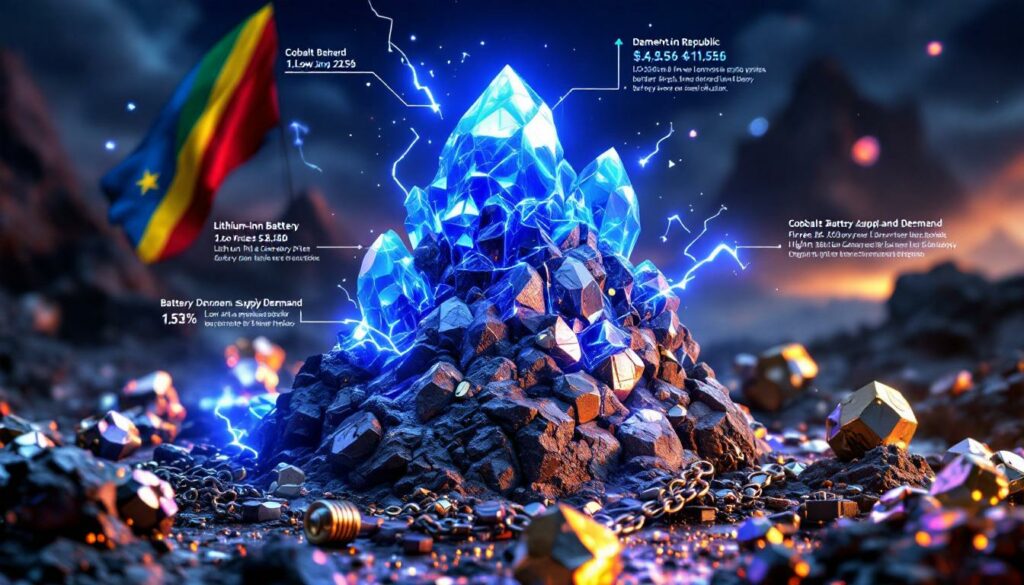What's Driving the Current Cobalt Market Volatility?
The refined cobalt market is experiencing significant price oscillations as suppliers and buyers engage in a strategic standoff. Low-end refined cobalt prices have risen slightly while high-end prices remain stable, creating a split pricing pattern that highlights the complex forces at work. This volatility stems from mining disruptions, fluctuating downstream demand, and strategic inventory management across the supply chain.
Force majeure declarations by key miners have significantly disrupted the cobalt supply chain, creating a ripple effect throughout the market. According to Shanghai Metal Market (SMM) data from July 2023, these disruptions have strengthened the negotiating position of miners and traders, many of whom have suspended quotations or raised prices in response.
"The force majeure announcements have boosted bullish sentiment among miners and traders, fundamentally altering the market's power dynamics in favor of suppliers," reports SMM's Cobalt Morning Meeting Summary.
The impact extends beyond immediate price increases. Market participants face difficult decisions as traditional supply reliability has been compromised, forcing downstream buyers to reconsider their just-in-time procurement strategies that had worked effectively during periods of stable supply.
Recent Price Movements and Market Sentiment
The divergent price trends between low-end and high-end refined cobalt products reveal a market in transition. Low-grade material prices have increased due to limited availability, while premium brands maintain stable pricing despite weak purchasing interest. This unusual pattern indicates a market recalibrating after supply disruptions rather than responding to strong demand signals.
Traders with limited low-priced inventory have strategically adjusted their pricing positions, contributing significantly to the increase in low-end quotations. Meanwhile, ex-factory price increases for premium brands have prompted traders to maintain firm price positions for high-end material, creating a two-tier market dynamic.
Market sentiment has shifted from bearish to cautiously neutral, with suppliers demonstrating increased confidence in holding firm on prices despite lukewarm demand. This psychological shift marks an important turning point in the 2023 cobalt market cycle.
Supply Chain Disruptions Impact
The force majeure declarations have created cascading effects throughout the supply chain. When a major miner declares force majeure, it triggers a series of contractual adjustments:
- Long-term contract volumes may be reduced
- Spot market availability decreases dramatically
- Secondary suppliers gain temporary pricing power
- Downstream processors face raw material uncertainty
These disruptions have particularly affected Chinese processors who rely heavily on imported intermediates. With approximately 70% of global cobalt production analysis originating from the Democratic Republic of Congo (DRC), any disruption to the Congo-China supply corridor creates outsized market impacts.
The timing of these disruptions coincides with seasonal inventory rebuilding efforts, magnifying their market impact. Typically, processors build inventory in Q2-Q3 to prepare for Q4 demand surges, but current supply uncertainty has complicated these established patterns.
How Are Supply Factors Influencing the Cobalt Market?
The cobalt supply landscape is experiencing significant constraints across multiple fronts. From refined production limitations to raw material sourcing challenges and trader inventory strategies, each element contributes to the current market dynamics.
Refined Cobalt Production Constraints
Refined cobalt smelters have strategically prioritized fulfilling long-term contracts while limiting spot market offerings. This allocation strategy has reduced market liquidity, particularly for low-priced material, contributing to upward pressure on low-end quotations.
SMM reports that "smelters faced challenges such as operational losses and sluggish downstream demand," prompting many to postpone procurement activities. This cautious approach has led to a drawdown of existing inventory rather than active spot market engagement.
The production constraints aren't uniform across all processors. Large-scale integrated producers with access to captive raw material supplies have maintained more stable operations than independent refiners relying entirely on spot market intermediates. This disparity creates additional market segmentation beyond the simple low/high-end price divide.
Technical production factors also influence supply availability:
- Energy costs have risen significantly, particularly affecting electrolytic cobalt production
- Labor shortages at some facilities have reduced operational efficiency
- Maintenance schedules disrupted by parts shortages have affected plant reliability
Raw Material Sourcing Challenges
The Democratic Republic of Congo's export policies have created significant uncertainty in the cobalt intermediate products market. These regulatory changes, including the cobalt export suspension expected to take effect, are creating raw material shortages for Chinese processors in the coming months, providing additional upward momentum for prices.
"China's cobalt intermediate products are expected to face raw material shortages, providing upward momentum for prices," according to SMM analysis.
The DRC export delay policy represents part of a broader trend toward resource nationalism, where producing countries seek to capture more value from their natural resources by encouraging local processing. This fundamental shift challenges the established global cobalt supply chain structure that has historically favored overseas refining.
Additional raw material challenges include:
- Transportation bottlenecks between mining sites and ports
- Quality inconsistencies requiring more extensive processing
- Increasing ore grades required to meet environmental standards
- Competition from cobalt-free battery chemistry development
Trader Inventory Dynamics
Traders holding limited low-priced inventory have adjusted their pricing strategies, contributing to the increase in low-end quotations. Meanwhile, reports of ex-factory price increases for premium brands have prompted traders to maintain firm price positions for high-end material, despite weak downstream purchasing interest.
This trader behavior reflects careful inventory management amid market uncertainty. Rather than aggressively liquidating positions at lower prices, many traders have opted to await market clarity, effectively removing potential supply from immediate availability.
The trader inventory situation varies significantly by product type:
| Product Category | Trader Inventory Level | Pricing Strategy |
|---|---|---|
| Refined Cobalt Metal | Moderate | Firm with limited flexibility |
| Cobalt Sulphate | Low | Increasing for new material |
| Cobalt Chloride | Low-Moderate | Stable with resistance to discounting |
| Cobalt Oxide | Moderate | Wide range based on quality |
This inventory position creates a buffer that could either accelerate or dampen price movements depending on how quickly traders decide to release material to the market.
What's Happening with Downstream Demand?
While supply constraints have dominated recent market narratives, downstream demand patterns play an equally important role in the tug-of-war between sellers and buyers in refined cobalt supply and demand.
Battery Sector Purchasing Patterns
Downstream battery manufacturers are demonstrating cautious purchasing behavior, primarily adopting just-in-time procurement strategies. This hesitancy reflects both high social inventory levels of refined cobalt and lackluster end-market demand signals.
SMM notes that "downstream producers continued to make just-in-time procurement, resulting in mediocre actual transactions." This procurement approach minimizes exposure to price volatility but also limits the market's ability to absorb supply disruptions smoothly.
The battery sector's purchasing patterns show notable divergence between different customer segments:
- Tier 1 EV battery makers: Maintain stable procurement through long-term contracts
- Consumer electronics battery producers: Showing reduced activity amid device market slowdown
- Energy storage system manufacturers: Increasing cobalt-containing cathode material purchases
- Portable power tool battery makers: Maintaining steady demand
This segmentation creates uneven demand pressure across different cobalt product categories and quality specifications.
Cobalt Compound Market Conditions
The markets for cobalt derivatives—including cobalt sulphate, cobalt chloride, and cobalt oxide (Co3O4)—are experiencing their own supply-demand tensions. While upstream suppliers maintain firm price positions, downstream buyers show limited purchasing enthusiasm, resulting in restricted transaction volumes.
Cobalt sulphate, the primary precursor for lithium-ion battery cathode materials, shows particularly complex market dynamics. New material is being quoted at higher prices, while transactions of older inventory continue at lower price points, creating a two-tier market that complicates price discovery.
Market activity metrics reveal the current demand-side hesitancy:
- Transaction volume: Below five-year average for Q3
- Inquiry-to-order conversion rate: Approximately 40% (down from typical 65%)
- Order size: Reduced by 15-20% compared to previous quarter
- Order frequency: Increased as buyers split larger orders to manage risk
These metrics indicate buyers are actively managing their exposure to price volatility while ensuring operational continuity.
Precursor and Cathode Material Trends
Ternary cathode precursor prices have seen slight increases, driven primarily by rising cobalt sulphate costs. However, this price movement lacks solid support from end-market demand, and battery cell manufacturers continue to hold significant bargaining power over discount coefficients.
The divergence between raw material costs and finished cathode material prices creates margin pressure throughout the supply chain. Precursor manufacturers face particularly challenging conditions as they absorb increased input costs while battling resistance to corresponding output price increases.
SMM reports that "downstream battery cell manufacturers showed little reaction to the rise in cobalt sulphate prices, and discount coefficients are expected to remain stable." This indicates battery makers' strong negotiating position despite rising input costs.
The technical distinction between different ternary cathode types adds another layer of complexity:
- NCM523 (5-series): Prices increasing due to higher cobalt content
- NCM622 (6-series): Slight corrections as manufacturers shift to lower-cobalt formulations
- NCM811 (8-series): Downward pressure as battery makers seek to reduce cobalt dependence
These divergent trends reflect the ongoing tension between established battery chemistries and the industry's efforts to reduce cobalt intensity.
How Are Different Cobalt Products Performing?
The cobalt market encompasses multiple product categories, each with distinct applications, pricing mechanisms, and market dynamics. Understanding these differences provides crucial insight into the overall market trajectory.
Cobalt Sulphate Market Analysis
The cobalt sulphate market continues to fluctuate as suppliers raise quotations for new material while some transactions of older inventory occur at lower prices. Significant price disparities between buyers and sellers persist, with upstream suppliers refusing to budge while downstream buyers demonstrate weak purchasing interest.
According to SMM, "upstream suppliers refused to budge on prices, while downstream buyers showed weak purchase willingness." This standoff has created a transaction environment characterized by limited volume and price discovery challenges.
The market segmentation by production date creates unusual arbitrage opportunities:
- Newly produced material: Higher prices reflecting current production costs
- Older inventory: Discounted to encourage transactions
- Imported vs. domestic: Price differential based on quality and certification
This fragmentation makes traditional price indexes less representative of actual market conditions and complicates procurement planning for end users.
Cobalt Chloride Price Trends
Current cobalt chloride quotations range between 61,000-63,000 yuan/mt, with market activity remaining sluggish. Although smelters are quoting higher prices, actual transactions are occurring around 61,000 yuan/mt, with only occasional deals at 62,000 yuan/mt.
The limited transaction volume in cobalt chloride highlights broader issues in specialty applications. End-use sectors for cobalt chloride include:
- Catalyst production for petroleum refining
- Specialty glass and ceramic colorants
- Agricultural feed additives
- Electroplating applications
Each of these sectors experiences distinct demand cycles, creating an uneven overall demand pattern for cobalt chloride that currently trends toward weakness.
Cobalt Oxide (Co3O4) Market Conditions
Co3O4 quotations currently range from 200,000-220,000 yuan/mt, with limited spot market activity. Producers indicate shipment expectations at 210,000-220,000 yuan/mt, but high-priced transactions remain scarce as both suppliers and buyers adopt cautious positions.
SMM notes that "Co3O4 producers indicated shipment expectations at 210,000-220,000 yuan/mt, but high-priced transactions remained limited." This price resistance reflects uncertainty about future lithium cobalt oxide (LCO) cathode demand.
The Co3O4 market faces unique challenges:
- High purity requirements for battery applications
- Strong correlation with lithium carbonate prices
- Seasonal demand patterns from consumer electronics
- Competition from alternative cathode materials
Producer discipline has prevented significant price erosion despite demand weakness, creating a market equilibrium that could shift quickly if end-market signals strengthen.
What's the Outlook for Cobalt Powder and Specialty Products?
Beyond the primary cobalt compounds used in batteries, specialty cobalt products serve diverse industrial applications with their own distinct market dynamics.
Cobalt Powder Market Dynamics
Raw material import delays have kept cobalt powder quotations firm at elevated levels. Despite increased inquiry activity from downstream alloy enterprises, actual trading volumes remain constrained as alloy producers balance high input costs against weak end-market demand.
SMM reports that "downstream alloy enterprises showed increased inquiry activity, but the alloy market demand remained sluggish." This contradiction between interest and action reflects underlying uncertainty about industrial demand recovery.
Cobalt powder specifications vary widely depending on application:
- Particle size: From sub-micron to several microns
- Morphology: Spherical, irregular, or dendritic
- Purity levels: 99.8% to 99.99%
- Oxygen content: Critical for certain applications
Each specification category commands different pricing and exhibits distinct supply-demand dynamics, creating a complex market landscape within the broader cobalt powder segment.
Specialty Cobalt Products Performance
Specialty cobalt products are experiencing their own market tensions, with producers maintaining high price expectations while buyers demonstrate limited purchasing enthusiasm. This standoff is expected to continue in the near term as market participants assess evolving supply-demand fundamentals.
The specialty cobalt product category includes:
- Cobalt acetate: Used in catalysts and paint driers
- Cobalt carbonate: Precursor for various cobalt chemicals
- Cobalt hydroxide: Intermediate product for further refining
- Cobalt nitrate: Used in catalysts and pigments
Each product serves distinct industrial niches, with varying degrees of substitutability and price elasticity. Current market conditions show divergent performance across these specialties, with products serving growth industries maintaining stronger price positions than those serving traditional industrial applications.
The specialty market segment is particularly sensitive to logistics factors:
- Shipping container availability affects export capabilities
- Warehousing costs impact inventory holding decisions
- Product shelf-life considerations influence production scheduling
- Packaging requirements add to overall delivered costs
These factors create additional complexity beyond simple supply-demand balances, particularly for products with specialized handling requirements.
How Are Cobalt Prices Affecting Battery Materials?
The relationship between cobalt prices and finished battery materials represents a critical link in the value chain, influencing both production economics and technology development paths.
Impact on Ternary Cathode Materials
Prices for 5-series ternary cathode materials have increased, while 6-series and 8-series products have seen slight corrections. These divergent trends reflect the complex interplay of raw material costs, with rising cobalt sulphate and lithium carbonate prices providing support for certain product categories.
The varying cobalt content across different NCM formulations creates distinct cost sensitivities:
| Cathode Type | Cobalt Content | Price Sensitivity to Cobalt | Current Trend |
|---|---|---|---|
| NCM 523 | ~10% | High | Increasing |
| NCM 622 | ~6% | Moderate | Slight correction |
| NCM 811 | ~3% | Low | Downward pressure |
This differentiation highlights how battery material manufacturers are navigating the current cobalt price environment, with some shifting toward lower-cobalt formulations while others maintain traditional compositions for specific performance requirements.
SMM notes that "battery cell manufacturers showed little reaction to the rise in cobalt sulphate prices, and discount coefficients are expected to remain stable." This reflects the industry's developed mechanisms for managing raw material volatility through contractual structures.
LCO Cathode Material Price Movements
LCO (lithium cobalt oxide) prices have seen significant increases driven by rising costs for both battery-grade lithium carbonate and Co3O4. However, end-use demand is entering a seasonal lull, creating tension between rising input costs and weakening market demand.
The LCO market faces unique challenges:
- Highest cobalt intensity among major cathode types (~60%)
- Primarily used in consumer electronics rather than EVs
- Sensitive to seasonal consumer product cycles
- Technically mature with limited substitution options
These factors make LCO particularly vulnerable to cobalt price volatility while simultaneously limiting manufacturers' ability to reformulate or substitute materials.
The current price movement contradicts typical seasonal patterns, which historically show weakness in Q3 ahead of Q4 consumer electronics production surges. This unusual pattern indicates the supply-side constraints are outweighing normal demand cyclicality.
What Factors Will Determine Future Cobalt Price Movements?
The cobalt market's future trajectory depends on several critical factors spanning supply, demand, inventory, and policy considerations.
Short-Term Market Outlook
In the short term, refined cobalt prices are expected to maintain a fluctuating trend as the tug-of-war between sellers and buyers in refined cobalt supply and demand continues. The market awaits clearer signals from actual transaction data to establish a more definitive price direction.
SMM analysis indicates price direction will depend on:
- Resolution timing for current force majeure situations
- Actual implementation impact of DRC export policies
- Transaction volume recovery in key downstream segments
- Inventory drawdown rates throughout the supply chain
These factors create a complex decision environment for market participants planning procurement and production strategies for the coming quarter.
"Whether existing industry inventory can sustain market needs until year-end will be a key factor affecting price trajectories," according to [the Cobalt Institute's latest market report](https
Ready to Get Ahead of Major Mineral Discoveries?
Don't miss out on the next significant cobalt discovery or mining opportunity. Stay informed with real-time alerts on ASX mineral discoveries through Discovery Alert's proprietary Discovery IQ model, turning complex market data into actionable investment insights at https://discoveryalert.com.au/discoveries/.




